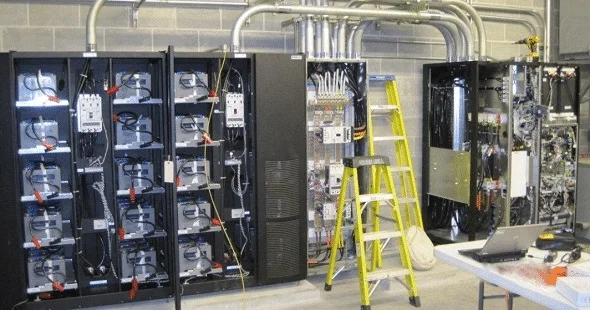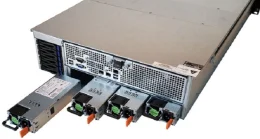How To Choose A Server Room or Datacentre UPS System
When it comes to uninterruptible power supplies there are several key choices to make. Get it right and you will have a perfectly sized UPS system that will give you years of protection. So how do you go about choosing a UPS system that is right for your systems?
What Does A UPS System Do?
An uninterruptible power supply provides power protection from a range of power problems when the mains power supply is present. Typical power problems can include: sags, surges, brownouts, spikes and electrical noise. A UPS system will also provide protection from momentary power outages and longer durations breaks in the mains power supply using a battery set which may be installed inside the UPS or connected in an external battery pack. The battery will typically be a Valve Regulated Lead Acid (VRLA) maintenance free battery with some systems now offering Lithium-ion battery options.
The Different Types of UPS Available
There are three main types of UPS topology (IEC 62040-3) and each differs in the level of power protection they provide to their connected loads whether in a server room, datacentre or industrial facility.
Standby/Off-line UPS systems: provide basic power protection and are generally limited in size to applications below 1kVA. They are low-cost, low specification devices that provide some protection when mains power in presence in the form of a filtering circuit and a battery supply when the mains power supply fails. The inverter could show a break in supply transfer (battery to load) of up to 10ms and rather than a sinewave output may generate a square or step wave supply. The generally accepted norm is that standby/off-line UPS are suitable for small IT and computer applications. These types of UPS are classed as voltage and frequency dependent (VFD) meaning that aside from a power outage, whatever the mains power supply voltage or frequency is, passes through to the load.
Line interactive UPS systems: are classed as voltage independent (VI) and generally provide a stabilised output with a battery power inverter that transfers in quicker than an off-line/standby UPS. Some line interactive UPS provide a square-wave output and some a sinewave output. Line interactive UPS may require oversizing to achieve the runtime required or be available with battery extension packs. Line interactive UPS tend to run to system sizes around 2-3kVA.
Online UPS systems: are classed as voltage and frequency independent (VFI). They have an inverter which is constantly running and generates a digital sinewave output. The quality of this output is almost always (aside from any internal fault) of a higher quality and purity than that of the mains power supply. Online UPS provide longer runtime battery pack options and provide inherently more reliable power protection. Should the UPS system be overload or develop an internal fault, an internal bypass (normally static) transfers the load automatically to the mains power supply when present. On-line UPS are available in single and three phase formats (1/1, 3/1 or 3/3 configurations) and may be tower, rackmount and offer parallel connection to scale up or provide added resilience (N+X redundancy). The maximum typical size for a single-phase UPS is 20kVA and for a three phase UPS this can be up to 1000kVA (1MVA) or more.
See: https://www.apc.com/salestools/JSII-5YQSBR/JSII-5YQSBR_R1_EN.pdf for technical diagrams and further information on IEC 62040-3.
UPS Load Sizing
The first stage of any UPS project is to identify all the loads that require UPS protection. Some are obvious such as desktop PC, network file server or server rack within a server room or datacentre environment.
Other loads may not be so obvious and can include any related connectivity and network devices. The rapid rise in Edge computing and Internet of Things (IoT) related connections will expose those installations to network operational and connectivity issues if they are not fully protected by an uninterruptible power system.
Most UPS systems are sized in VA which is often referred to as ‘Apparent Power’. VA = supply Voltage x drawn Amps. When measured in units of 1000, VA becomes kVA. Most loads have an Amps rating and for the UK we work with 230Vac for a single-phase supply.
For three phase loads the same process applies and we work with a 400Vac three-phase supply. The calculation here being based on adding together the VA calculated for each phase. If the Watts or kilowatts (kW) can be measured then this is referred to as the ‘Real Power’ drawn by the load.
A comprehensive list can help to estimate the size of UPS system required and this can be verified by Server Room Environments during a UPS site survey.
UPS Systems and Standby Generators
Once you have a list of the devices to be protected and their sizes it is then important to rank them in order of priority and identify how long you want to provide protection for when there is a mains power supply failure. Some IT devices can be dropped automatically (known as load shedding) when there is a power outage including network printers whilst more critical devices will need to ride out the power outage or be closed-down in an orderly manner. There may be a local standby power generator that powers up when the mains power supply fails, or you may have to oversize of consider a larger UPS battery set to cover the runtime duration required for your site.
Centralised or Decentralised UPS
As the size of a UPS installation grows it becomes important to consider whether to opt for a centralised (single) uninterruptible power supply to support the entire installation or to choose a decentralised approach using multiple UPS devices. Other related considerations here include:
- Load power distribution units
- Hardwired load connections
- Static or source transfer switches
- Hardwired or plug-in UPS input supplies
- UPS maintenance bypasses
- Remote UPS monitoring and alarm interfaces
- UPS maintenance contracts
- Modular UPS or Monoblock UPS
Modular UPS systems have grown in popularity in recent years as several UPS manufacturers now offer this type of technology. The standard UPS system available used to be a monoblock (mono-block) single uninterruptible power supply unit. If an installation required redundancy in the form of N+X or additional capacity, two or more monoblock UPS systems were connected in parallel.
Modular UPS have a standard module UPS size and standard frame sizes particular to each UPS manufacturing company. The UPS frame can house a number of UPS modules, arranged to provide N+X resilience and expansion capacity. Modular UPS can be right-sized for day-one applications whilst allowing the infrastructure to be installed to allow easy future expansion using additional plug-in modules.
Server Room Environments supplies a complete range of UPS systems and can deliver complete ‘turn-key’ packages including electrical installation, battery builds and commissioning. If you would like to discuss your next server room or datacentre UPS project please contact us and we can arrange a site survey.


























